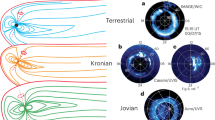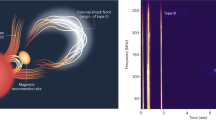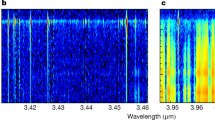Abstract
Radio emissions from Jupiter provided the first evidence that this giant planet has a strong magnetic field1,2 and a large magnetosphere3. Jupiter also has polar aurorae4, which are similar in many respects to Earth's aurorae5. The radio emissions are believed to be generated along the high-latitude magnetic field lines by the same electrons that produce the aurorae, and both the radio emission in the hectometric frequency range and the aurorae vary considerably6,7. The origin of the variability, however, has been poorly understood. Here we report simultaneous observations using the Cassini and Galileo spacecraft of hectometric radio emissions and extreme ultraviolet auroral emissions from Jupiter. Our results show that both of these emissions are triggered by interplanetary shocks propagating outward from the Sun. When such a shock arrives at Jupiter, it seems to cause a major compression and reconfiguration of the magnetosphere, which produces strong electric fields and therefore electron acceleration along the auroral field lines, similar to the processes that occur during geomagnetic storms at the Earth.
This is a preview of subscription content, access via your institution
Access options
Subscribe to this journal
Receive 51 print issues and online access
$199.00 per year
only $3.90 per issue
Buy this article
- Purchase on SpringerLink
- Instant access to full article PDF
Prices may be subject to local taxes which are calculated during checkout




Similar content being viewed by others
References
Burke, B. F. & Franklin, K. L. Observations of a variable radio source associated with the planet Jupiter. J. Geophys. Res. 60, 213–217 (1955).
Drake, F. D. & Hvatum, S. Non-thermal microwave radiation from Jupiter. Astron. J. 64, 329–330 (1959).
Warwick, J. W. Radiophysics of Jupiter. Space Sci. Rev. 6, 841–891 (1967).
Broadfoot, A. L. et al. Extreme ultraviolet observations from Voyager 1 encounter with Jupiter. Science 204, 979–982 (1979).
Chamberlain, J. W. Physics of the Aurora and Airglow (Academic, New York, 1961).
Carr, T. D., Desch, M. D. & Alexander, J. K. in Physics of the Jovian Magnetosphere (ed. Dessler, A. J.) 226–284 (Cambridge Univ. Press, Cambridge, 1983).
Clarke, J. T., Moos, H. W., Atreya, S. K. & Lane, A. L. Observations from Earth orbit and variability of the polar aurora on Jupiter. Astrophys. J. 241, L179–L1182 (1980).
Gurnett, D. A. et al. The Cassini radio and plasma wave investigation. Space Sci. Rev. (in the press).
Warwick, J. W. et al. Voyager 1 planetary radio astronomy observations near Jupiter. Science 204, 995–998 (1979).
Wu, C. S. & Lee, L. C. A theory of terrestrial kilometric radiation. Astrophys. J. 213, 621–626 (1979).
Bigg, E. K. Influence of the satellite Io on Jupiter's decametric radiation. Nature 203, 1008–1010 (1964).
Goldreich, P. & Lynden-Bell, D. Io, a unipolar inductor. Astrophys. J. 156, 59–78 (1969).
Queinnec, J. & Zarka, P. Io-controlled decametric arcs and Io–Jupiter interaction. J. Geophys. Res. 103, 26649–26666 (1998).
Ladreiter, H. P., Zarka, P. & Lecacheux, A. Direction finding study of Jovian hectometric and broadband kilometric radio emissions: Evidence for their auroral origin. Planet. Space Sci. 42, 919–931 (1994).
Zarka, P. & Genoa, F. Low-frequency Jovian emission and solar wind magnetic sector structure. Nature 306, 767–768 (1983).
Desch, M. D. & Barrow, C. H. Direct evidence for solar wind control of Jupiter's hectometer-wavelength radio emission. J. Geophys. Res. 89, 6819–6823 (1984).
Gurnett, D. A. et al. The Galileo plasma wave investigation. Space Sci. Rev. 60, 341–355 (1992).
Scarf, F. L., Gurnett, D. A. & Kurth, W. S. Jupiter plasma wave observations: an initial Voyager 1 overview. Science 204, 991–995 (1979).
Gurnett, D. A. The Earth as a radio source: terrestrial kilometric radiation. J. Geophys. Res. 79, 4227–4238 (1974).
Voots, G. R., Gurnett, D. A. & Akasofu, S.-Y. Auroral kilometric radiation as an indicator of auroral magnetic disturbances. J. Geophys. Res. 82, 2259–2266 (1977).
Gallagher, D. L. & Gurnett, D. A. Auroral kilometric radiation: time-averaged source location. J. Geophys. Res. 84, 6501–6509 (1979).
Zarka, P. Auroral radio emissions at the outer planets: observations and theories. J. Geophys. Res. 103, 20159–20194 (1998).
Louarn, P. et al. Trapped electrons as a free energy source for the auroral kilometric radiation. J. Geophys. Res. 95, 5983–5995 (1990).
Ergun, R. E. et al. Electron-cyclotron maser driven by charge particle acceleration from magnetic field-alligned electric fields. Astrophys. J. 538, 456–466 (2000).
Huff, R. L. Mapping of auroral kilometric radiation sources to the aurora. J. Geophys. Res. 93, 11445–11454 (1988).
Clarke, J. T. et al. Hubble Space Telescope imaging of Jupiter's UV aurora during the Galileo orbiter mission. J. Geophys. Res. 103, 20217–20236 (1998).
Dougherty, M. K. et al. The Cassini magnetic field investigation. Space Sci. Rev. (submitted).
Young, D. T. et al. Cassini plasma spectrometer investigation. Space Sci. Rev. (submitted).
Esposito, L. W. et al. The Cassini ultraviolet imaging spectrograph investigation. Space Sci. Rev. (in the press).
Acknowledgements
The research at the University of Iowa, the University of Michigan, and the University of Colorado was supported by NASA through the Jet Propulsion Laboratory.
Author information
Authors and Affiliations
Corresponding author
Rights and permissions
About this article
Cite this article
Gurnett, D., Kurth, W., Hospodarsky, G. et al. Control of Jupiter's radio emission and aurorae by the solar wind. Nature 415, 985–987 (2002). https://doi.org/10.1038/415985a
Received:
Accepted:
Issue date:
DOI: https://doi.org/10.1038/415985a
This article is cited by
-
Acoustic waves in the Jovian dusty magnetosphere: a brief review and meta-analysis
Reviews of Modern Plasma Physics (2022)
-
The Juno Magnetic Field Investigation
Space Science Reviews (2017)
-
The Juno Waves Investigation
Space Science Reviews (2017)



